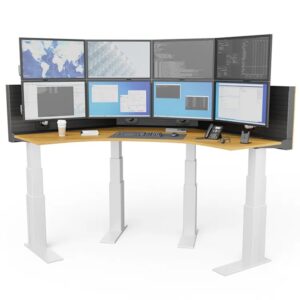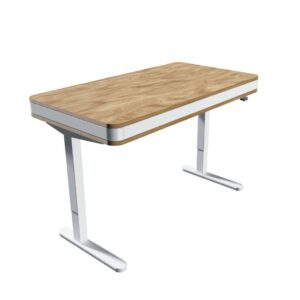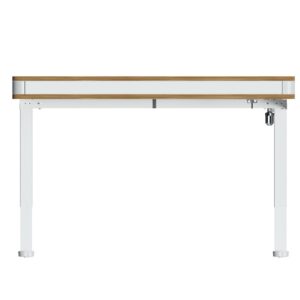L7 Motorized standing desk for control room
Motioncraft L5 motorized standing desk
Sit Stand Desks or Monitor Risers: What is the Best Solution for your Ergonomics Problem.
With more and more people embracing working from home, it is high time to rethink your setups if you are not properly comfortable or lack the productivity loop. Bad desk ergonomics can cause neck & back pain and eye strain. Two of the more common ones are sit-stand desks and monitor risers. Both options are ergonomically beneficial, but they have some ups and downs. We will look at how sit-stand desks can help resolve these issues, whether monitor risers are a good option or if you should consider other alternatives and advice for correct ergonomic screen positioning about their conversation.
Are Monitor Risers Worth It?
What is a Monitor Riser? Your monitor wants to be at the eye level because of this your head, neck and again are in a impartial place as you figure. This ensures less stress on the spine, reduces your slouch and improves posture.
Monitor risers provide both a money-saving and small-footprint option for those with limited desk space. If you want to upgrade your setup and improve posture, as well gain more available space on the desk for minimal clearance, an adjustable monitor arm might be exactly what you have been looking for. Nonetheless, there are restrictions:
- Height that will not be changed: a lot of risers do have set heights, so you may without issues want to fill or study down in case your eye-pinnacle is under the maximum protest stage.
- Work Area Flexibility: A riser doea not provide the same opportunity to change position on a regular basis as would a sit-stand desk.
- EXTRAS: Depending how high you have this riser solution and if you are standing for long durations, don’t forget a few extras to make your work that much more comfortable.
What is a Monitor Riser Alternative?
Alternate methods for raising screen heightYou can use adifferent method to achieve the right positioning of your monitor if you choose not to go with a monitor riser.
- Stack of books/sturdy boxes – You can place a stack of your favorite read or sturdy box on the worktop to elevate monitor but it is less aesthetically pleasing and adjustable.
- Articulating monitor arms: You can also mount your display on the edge of your desk, and you will be able to move it up or down or side to side easily with these adjustable arms. Have greater versatility than regular risers.
- Setting up height-adjustable desks: If you have sit-stand desk, obviously it easier to set the right standing position. This eliminates the need for extra accessories.
What Is The Thing Name A Monitor Stand?
Monitor risers are also called by these names;
- Monitor stands
- Monitor shelves
- Monitor elevators
- Ergonomic monitor platforms
They all serve the same function: risers for reaching at your screen so it mitigates neck strain and improves posture.
How Sit-Stand Desks Address This
As the name suggests, a sit-stand desk is exactly what it sounds like — an adjustable workstation that lets you switch between sitting and standing during your work day. This flexibility provides several benefits over dedicated monitor risers:
- Full height management: It could possibly alter your comprehensive workspace which includes keep an eye on, keyboard and mouse. This means you will be able to comfortably sit or stand in the correct ergonomic positioning.
- Encourages movement: Frequent transition between sitting and standing breaks the unpleasant consequences of excessive seating like having backache, decreased circulation system, fatigue etc.
- Better posture: Set the desk height so that your monitor is at eye level, negating the need to tilt our head up or down.
- Adjustable for more than one user: Sit-stand desks work best in shared workplaces Cool things about sit stand-desk — they can adjust to the height of almost everyone.
How Should You Angle Your Monitor?
The monitor must be placed properly under both sitting and standing position when using a sit-stand desk. There are many factors behind how you should tilt your monitor, but the best solution is…
- Is a vertical tilt: Most of these monitors will have the option to rotate screen for. It has a gentle upward slant of an extra 10-20 degrees beyond vertical, making it closer to just about the perfect viewing angle you can get. This will keep the head of yours level with your display screen without straining their neck.
- Reduce monitor angle too far to the left or right –horizontal tilt. Align the screen with your body center line, so you do not bend or curl up and avoid twisting neck & shoulder strain.
- Elevated to eye level: Align the top of your monitor at or just below eyeline. No matter where you are positioned in the vehicle, your eyes should be focused on approximately the top third of the screen when looking straight ahead.
Conclusion
Monitor stands are a great friendly budget and with some screen arm, especially for someone who need flexible adjust which stand will not bring that there. This is where a sit-stand desk comes in, as it provides the perfect hybrid of flexibility by letting you adjust the entire workspace to encourage movement and healthier posture habits. Whether it is a monitor riser, an adjustable height desk or an articulating arm the key to good placement is in reducing strain and facilitating long term health.




